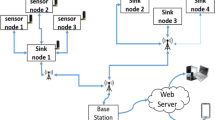Abstract
Aiming to the emergency monitored of sudden pollution incidents and abnormal conditions, a portable water quality analyzer with multi-parameter was developed. The analyzer had an original rapid water-quality test tube of self-suction style and took the intelligent color automatic recognition system as its kernel. The analyzer realized the fast and quantitative measurement of the content in the water source, and implemented the real-time wireless remote transmission of the testing information. The self-suction water quality fast test tube had chosen good transparency and uniform material as the carrier and adopted unique vacuum technology to effectively solve the problem of testing liquid storage and quantitative sampling. By integrating Beidou positioning and the short message service function of GPRS, two kinds of wireless network technologies, to integrate it into the wisdom environmental monitoring system with sky, space and ground. Test results showed that the water quality analyzer met the design requirements of emergency monitoring.






Similar content being viewed by others
References
Zhao, S., Yu, J., Wang, Z., et al. (2011). Multi-function self-validating water quality monitoring sensor based on relevance vector machine. Chinese Journal of Scientific Instrument, 32(8), 1690–1695.
Li, S., Bai, L., Liu, S., et al. (2010). Research and technical innovation of rapid test method for water quality analysis. In Proceedings of the 2010 annual meeting of the Chinese society for environmental sciences (pp. 2050–2053).
Xiao-zhen, H., Zhi-yu, W., Ying-ke, X., et al. (2014). Software design of control and signal processing system for multi-parameter water quality detecting instrument. Instrument Technique and Sensor, 8, 20–22.
Jia-jia, M., Qian, R., & Wei-feng, Q. (2012). High-precision signal acquisition and processing for ultraviolet-visible spectrophotometer. Instrument Technique and Sensor, 7, 16–17.
Hang-tao, Y., Shuang-bao, W., & Cheng-long, W. (2012). Design of water ammonia nitrogen detection system based on spectrophotometry. Measurement and Control Technology, 31(5), 49–52.
Fogelman, S., Zhao, H., & Blumenstein, M. (2006). A rapid analytical method for predicting the oxygen demand of wastewater. Analytical and Bioanalytical Chemistry, 386(6), 1773–1779.
Kang-lin, W., Ming, C., Zhi-yu, W., et al. (2014). Research on signal processing for water quality monitoring based on continuous spectral analysis. Guang Pu Xue Yu Guang Pu Fen Xi, 34(12), 3368–3373.
Hua, F., Na, L., Kun, Z., et al. (2012). Portable gas detector based on ATMEGA16. Chinese Journal of Sensors and Actuators, 9, 1322–1326.
Wei, K., Wen, Z., Guo, J., et al. (2012). The design and experiment of multi-parameter water quality monitoring microsystem based on MOEMS microspectrometer. Guang Pu Xue Yu Guang Pu Fen Xi, 32(7), 2009–2014.
Li, Y., Zhao, G., Liu, L., et al. (2013). Research on visual normalization of multi-camera image stitching. Computer Engineering & Applications, 10, 188–192.
Liu, M., Du, X., & Xia, L. (2013). Anomaly detection method based on separable local projection in hyperspectral imagery. Journal of Image and Graphics, 18(5), 558–564.
Kong, X., Gu, X., Tao, Y., et al. (2012). Research on end-to-end thermal infrared remote sensing image simulation algorithm. Application Research of Computers, 10, 3976–3979.
Ailian, L., Shaofeng, X., & Huiting, W. (2013). Realization of rubber vulcanizing intelligent control system based on STM32. Computer Measurement and Control, 7, 1838–1842.
Hui, L., Wen-cheng, G., & Hao, C. (2012). Motor control system in transfer robot based on STM32F107. Microcontrollers and Embedded Systems, 4, 36–38.
Yue, B., & Li, X. (2012). Development of the USB-CAN converter based on CotexM3. Computer Engineering & Science, 34(5), 68–72.
Zhang, J., Yang, Y., Zhang, J., et al. (2013). Color reproduction and classification with TCS3200D. Engineering Journal of Wuhan University, 46(2), 257–260.
Wang, T., Jiao, J., Wang, Q., et al. (2015). Portable high-resolution chroma analyzer based on STM32. Instrument Technique and Sensor, 11, 49–51.
Wang, B., Yu, J., & Chen, W. (2013). Design of second generation beidou navigation receiver. Microcontrollers and Embedded Systems, 7, 39–43.
Bai, Z., Rong, Y., & Jingjun, G. (2014). Performing centimeter-level relative positioning using BeiDou navigation satellite system. Bulletin of Surveying and Mapping, 7, 11–13.
Jiachun, A., Zemin, W., Zhigang, H., et al. (2013). Positioning analysis of Beidou-2/compass in China and surrounding seas. Journal of Geodesy and Geodynamics, 33(3), 83–86.
Acknowledgements
The authors acknowledge the painstaking efforts of the research team members.
Author information
Authors and Affiliations
Corresponding author
Rights and permissions
About this article
Cite this article
Xiong, J., Wang, T. Design of Multi-parameter Portable Water Quality Detector Based on Wireless Network. Wireless Pers Commun 102, 1891–1904 (2018). https://doi.org/10.1007/s11277-018-5244-1
Published:
Issue Date:
DOI: https://doi.org/10.1007/s11277-018-5244-1




